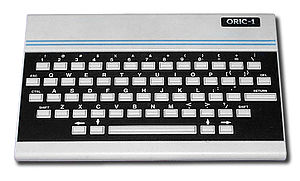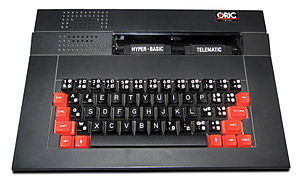- Tangerine Computer Systems
-
For the Atmos Clock, see Atmos clock.
British microcomputer company Tangerine Computer Systems[1] was founded in 1979 by Dr. Paul Johnson, Mark Rainer and Nigel Penton Tilbury in St. Ives, Cambridgeshire
The very first product was the successful TAN1648 VDU kit which received much acclaim in the technical press.
The home computer market was beginning to move, albeit slowly, and it was essential to establish a presence. Development and expansion was imperative. It was decided that the latter two partners would relinquish their involvement in order to focus on their consultancy work.
Barry Muncaster became involved operationally and the company moved to new premises in Ely, Cambridgeshire. The company was later renamed, and was known for most of the 1980s as Oric Products International.
Contents
Microtan 65
Main article: Tangerine MICROTAN 65 The Microtan 65 in the full System Rack enclosure and with the ASCII keyboard
The Microtan 65 in the full System Rack enclosure and with the ASCII keyboard
Tangerine produced one of the first 6502-based kit computers, the Microtan 65. It had a 3U form factor, a small amount of memory (RAM), a video character generator and UHF modulator for use with a TV set, and a simple latch for entering hex data from a keypad, and the computer was designed to be expandable. The manual came with a one-kilobyte listing of Conway's Game of Life. An optional expansion board could be built with a UART, more memory and BASIC ROMs. Additional expansion boards became available later, offering more RAM, dedicated serial and parallel I/O boards, etc.
After the Microtan 65, Tangerine planned to build a desktop machine and managed to get as far as selling the design for the Microtan 2 also known as Tangerine Tiger to a company who never built it.
Oric-1
With the success of the Sinclair ZX Spectrum Tangerine's backers suggested a home computer and Tangerine formed Oric Products International Ltd to develop and release the Oric-1 in 1983. Based on a 1 MHz 6502A CPU, it came in 16 KB or 48 KB RAM [2] variants for £129 and £169 respectively, matching the models available for the popular ZX Spectrum and undercutting the price of the 48K Spectrum by a few pounds. Both Oric-1 versions had a 16 KB ROM containing the operating system and a modified BASIC interpreter.
The Oric-1 improved somewhat over the Spectrum with a different keyboard design replacing the Spectrum's renowned "dead flesh" one. In addition the Oric had a true sound chip, the programmable GI 8912, and two graphical modes handled by a semi-custom ASIC (ULA) which also managed the interface between the processor and memory. The two modes were a LORES text only mode (though the character set could be redefined to produce graphics) with 28 rows of 40 characters and a HIRES mode with 200 rows of 240 pixels above three lines of text. Like the Spectrum, the Oric-1 suffered from attribute clash—albeit to a lesser degree in HIRES mode, when a single row of pixels could be coloured differently from the one below in contrast to the Spectrum, which applied foreground and background color in 8 x 8 pixel blocks. As it was meant for the home market, it had a built in television RF modulator as well as RGB output and was meant to work with a basic audio tape recorder to save and load data. Error-checking of recorded programs was bugged, frequently causing user-created programs to fail when loaded back in. A nice feature was an almost standard (except for the connector) Centronics printer interface.
According to the Oric World website (see External links, below), about 160,000 Oric-1s were sold in the UK in 1983 with another 50,000 sold in France (where it was the top-selling machine that year). Although not the 350,000 predicted, it was enough for Oric International to be bought out by Edenspring and given £4m in funding.
In 1983 the first communications software for both the Oric 1 and Oric Atmos were produced (Oricoms and Atcoms). This software, written by John Henry Patrick Rushton and accompanying manual (Written by Trevor F Shaw) - both of Telford, Shropshire - utilised the 6522 ACIA (Asynchronous Communications Interface Adaptor which served as a I/O port controller for the 6502 family of microprocessors). This software (the first of its type for the Oric series of computers and indeed one of the early pioneers of home computer communications) enabled the Oric 1 and Atmos to communicate with Prestel (a fore-runner of the Internet-which used Ceefax style graphics), with Bulletin Boards and facilitated the transfer of files from one Oric/Atmos to another, via the public telephone system. The transfer speeds being either 300 or 1200 baud (this could occur at both full and half duplex). John H P Rushton was later - in the spring of 1984- to produce the first (for the Oric 1 and Atmos) 'true' high resolution Computer Aided Design utilities (C.A.D.) known as Oricad and Atcad respectively.
On the 13th October, 1983 the factory of Kenure Plastics in Berkshire, where the Oric-1 was manufactured, burnt to the ground. The factory was rebuilt, minus a considerable stock of bits (including 15,000 old ROMs) that went to make up the Oric-1. In the meantime production was said to have restarted within 24 hours in a new factory; And just a day later, a neighbouring warehouse went up in flames. Police were said at the time to suspect that the arsonist got the wrong place first time round. It was about this time, too, that Tansoft upped sticks and moved to co-exist with Oric Research at the Techno Park, Cambridge.
Oric Atmos
The Edenspring money enabled Oric International to release the Oric Atmos, which added a true keyboard and an updated V1.1 ROM to the Oric-1. The faulty tape error checking routine was still there. Soon after the Atmos was released, the modem, printer and 3.5 -inch floppy disk drive originally promised for the Oric-1 were announced and released by the end of 1984. A short time after the release of the Atmos machine, a modification for the Oric-1 was issued and advertised in magazines and bulletin boards. This modification enabled the Oric-1 user to add a second rom (containing the Oric Atmos system) to a spare rom socket on the Oric-1 circuit board. Then, using a basic DPST (double pole single toggle) switch, the users could then switch between the new Oric Atmos rom and the original Oric-1 rom at their leisure.
Stratos, Telestrat, and the end
The Atmos failed to turn around Oric International's fortunes, but they persevered and in early 1985 Oric announced several new machines were on the way, including an IBM compatible and an MSX-compatible computer. On February 1 it demonstrated the Oric Stratos/IQ164 at the Frankfurt Computer Show; on the 2nd however, Edenspring put Oric International into receivership with Tansoft, by then a company in its own right, following in May. French company Eureka bought the remains of Oric and, after renaming itself, continued to produce the Stratos under that name, followed by the Oric Telestrat in late 1986. In December 1987 after announcing the Telestrat 2, Oric International went into receivership for the second and final time.
Clones
A Yugoslavian company (believed to be Avtotehna, based in Ljubljana) obtained a licence to make just 5000 machines. Machines were made, but whether they were under license or not is not known in any detail. It is thought[by whom?] that they assembled parts shipped from the UK. They were Atmos based, the only difference being the logo indicating Oric Nova 64 instead of Oric Atmos 48k. Nova had 64K of RAM, 16K of which was masked by the ROM at startup, leaving 48K to work with the BASIC language.
A Bulgarian machine called the Pravetz 8D was produced between 1985 and 1991. The Pravetz is entirely hardware and software compatible with the Oric Atmos. The biggest change on the hardware side is the larger white case that hosts a comfortable mechanical keyboard and an integrated power supply. The BASIC ROM has been patched to host both a Western European and Cyrillic alphabet – the upper case character set produces Western European characters, while lower case gives Cyrillic letters. In order to ease the use of the two alphabets, the Pravetz 8D is fitted with a Caps Lock key. A Disk II compatible interface and a custom DOS, called DOS-8D, were created in 1987-1988 by Borislav Zahariev.
References
- ^ The choice of the company's name, Tangerine, was inspired by the success of the-then already famous (in the computer business world) Apple Computer.
- ^ The 48K Oric machines are actually 64K machines. The top 16K of memory are masked by the BASIC ROM and thus normally not available for the user. The disc drive unit contains some additional hardware that allows it to enable or disable the ROM, effectively adding 16K of RAM to the machine. This additional memory is used by the system to store the Oric DOS software.
External links
Link portals
- Oric.org – The main Oric community portal
- The Oric FAQ – For Microtan 65, Oric 1, Oric Atmos & Stratos IQ164/Telestrat; website by James Groom
- Defence-Force: Oric Forums – The main Oric discussion forum
- Oric games – specialised for games (tests & forums)
History
- Oric World – Including an online version of the book by Haworth
- Oric Atmos review – By David Scobie, Your Computer, March 1984 (text stored at the Home Computer Hall of Fame)
- Microtan 65 – Oric-1 – Oric Atmos – At the Old Computers Museum
- Oric Nova - licenced machine, exact copy of Atmos, at the Old Computers Museum
- Pravetz 8D - the only clone of Oric, at the Old Computers Museum
Emulators
- Emulators – Links to up-to-date versions of Euphoric, Amoric, Atoric, Arcoric and Mess emulators
- Oricutron - A new multiplatform Oric emulator
Other
- Defence-Force: Oric page – By Mickaël Pointier
Categories:- Defunct companies of the United Kingdom
- Early microcomputers
- Defunct computer hardware companies
- Home computers
Wikimedia Foundation. 2010.




